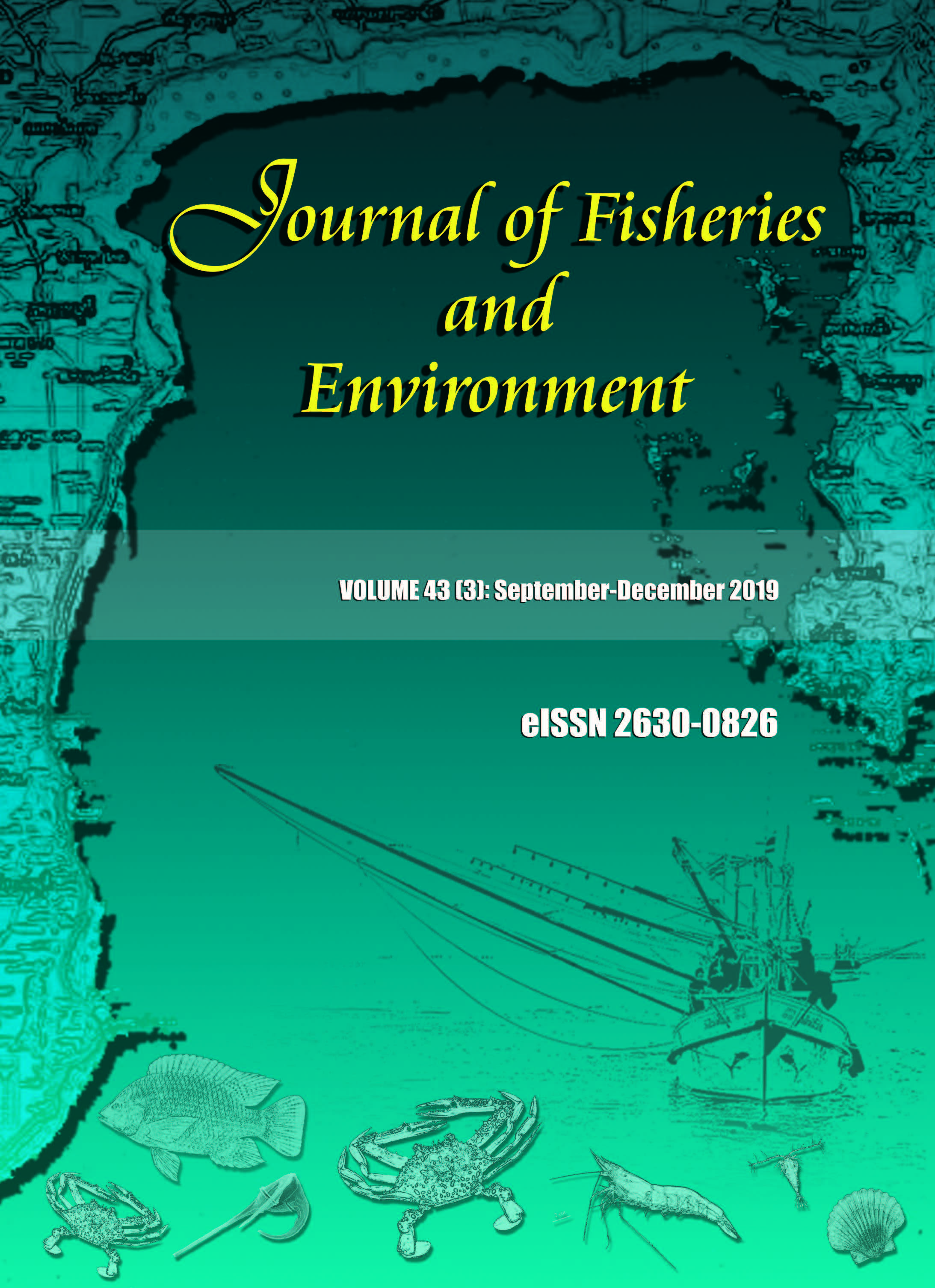Effect of Different Feed Loading on Sediment Accumulation Rate and Carbon Burial Rate in the Polyculture System of Nile Tilapia (Oreochromis niloticus) and Pacific White Shrimp (Litopenaeus vannamei)
Main Article Content
Abstract
A study on the effect of different feed loading on sediment accumulation rate and carbon burial rate in the polyculture of Nile tilapia and Pacific white shrimp was conducted in six ponds located in Phan Thong District, Chonburi Province, in eastern Thailand. The ponds were grouped by level of feed loading: low, moderate and high. The sediment accumulation rate and other parameters were measured at three sites in each pond, one at the feeding area and two at the deep end of the pond. The ponds with high feed loading had the highest mean sediment accumulation rate (35.50±4.71 cm·yr-1), higher than the moderate (16.80±1.86 cm·yr-1) and low (5.40±0.00 cm·yr-1) groups. The group with high feed loading also had the highest mean carbon burial rate (69.87±17.16 g C·m-2·yr-1), significantly higher (p<0.05) than the groups with moderate (17.57±2.59 g C·m-2·yr-1) and low feed loading (6.19±1.23 g C·m-2·yr-1). The results suggest that sediment accumulation rate average exceeds 23.67 cm, the farmer should reduce feeding rate.
Article Details
References
2. Black, C.A. 1965. Methods of soil analysis. American Society of Agronomy. Madison, Wisconsin, USA. 1572 pp.
3. Blake, G.R. and K.H. Hartge. 1986. Bulk density. In: Methods of soil analysis. Part 2. Chemical and microbiological properties, Agronomy monograph 9.2 (eds. A.L. Page, R.H. Miller and D.R. Keeney), pp. 363-382. American Society of Agronomy, Soil Science Society of America, Madison, USA.
4. Boyd, C.E., C.W. Wood, P.L. Chaney and J.F. Queiroz. 2010. Role of aquaculture pond sediments in sequestration of annual global carbon emissions. Environmental Pollution 158: 2537-2540.
5. Boyd, C.E. 1995. Bottom soils, sediment and pond aquaculture. Alabama Agriculture Experiment Station, Auburn University, Alabama, USA. 365 pp.
6. Boyd, C.E. and C.S. Tucker. 2014. Handbook for aquaculture water quality. Craftmaster Printers, Auburn, Alabama, USA. 438 pp.
7. Boyd, C.E., C.W. Wood and T. Thunjai. 2002. Aquaculture pond bottom soil quality management. Pond Dynamics/Aquaculture Collaborative Research Support Program. Oregon State University. Corvallis, Oregon, USA. 41 pp.
8. Bremmer, J.M. and C.S. Mulvaney. 1982. Nitrogen-total. In: Methods of soil analysis. Part 2. Chemical and microbiological properties, Agronomy monograph 9.2 (eds. A.L. Page, R.H. Miller and D.R. Keeney), pp. 595-624. American Society of Agronomy, Soil Science Society of America, Madison, USA.
9. Dean, W.E. and E. Gorham. 1998. Magnitude and significance of carbon burial in lakes, reservoirs, and peatlands. Geology 26: 535-538.
10. Department of Fisheries (DOF). 2014. Fisheries statistics 2014. Information Center, Department of Fisheries, Bangkok, Thailand. 87 pp.
11. Nelson, D.W. and L.E. Sommers. 1982. Total carbon, organic carbon and organic matter. In: Methods of soil analysis. Part 2. Chemical and microbiological properties, Agronomy monograph 9.2 (eds. A.L. Page, R.H. Miller and D.R. Keeney), pp. 539-579. American Society of Agronomy, Soil Science Society of America, Madison, USA.
12. Olsen, S.R. and L.E. Sommer. 1982. Phosphorus. In: Methods of soil analysis. Part 2. Chemical and microbiological properties, Agronomy monograph 9.2 (eds. A.L. Page, R.H. Miller and D.R. Keeney), pp. 403-430. American Society of Agronomy, Soil Science Society of America, Madison, USA.
13. Steeby, J.A., J.A. Hargreaves, C.S. Tucker and S. Kingsbury. 2004. Accumulation, organic carbon and dry matter concentration of sediment in commercial channel catfish ponds. Aquaculture Engineering 30: 115-126.
14. Tape, Y. and C.E. Boyd. 2002. Sediment quality in Arkansas bait minnow ponds. Journal of the World Aquaculture Society 33: 221-232.
15. Thunjai, T., C.E. Boyd, and K. Dube. 2001. Pond soil pH measurement. Journal of the World Aquaculture Society 32(2): 141-152.
16. Weber, J.B. 1977. Soil properties, herbicide sorption, and model soil systems. In: Research method in weed science. 2nd ed. (ed. B. Truelove), pp. 59-62. Southern Weed Science Society, Auburn, USA.
17. Xing Y., P. Xie, Y. Hong, N. Leyi, W. Yuesi and K. Ronga. 2005. Methane and carbon dioxide fluxes from a shallow hypereutrophic subtropical Lake in China. Atmospheric Environment 39: 5532-5540.

